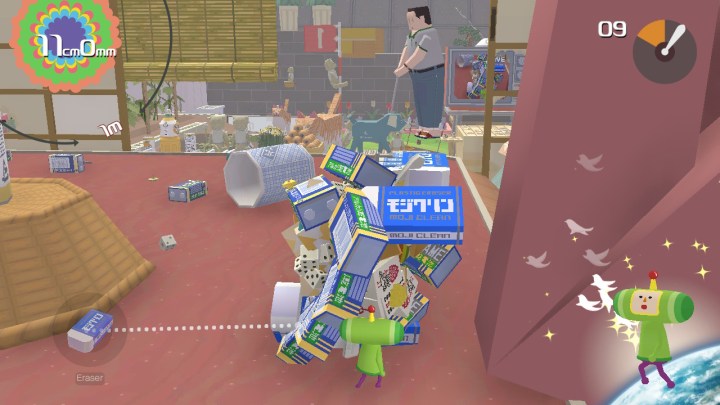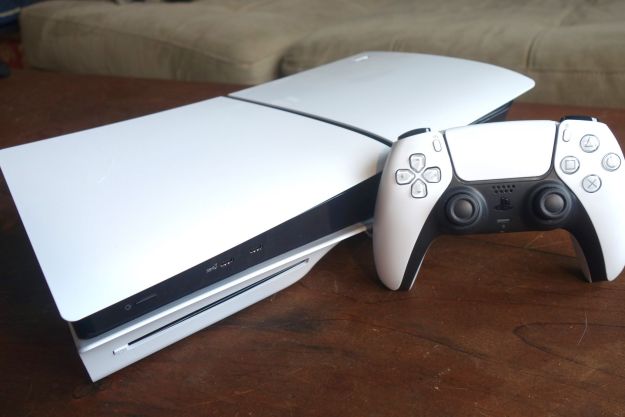
Katamari Damacy originally launched in 2004 on PlayStation 2. At that time, I was an awkward and weird 13-year-old, which made that quirky game about rolling over stuff with a ball resonate with me. I looked weird. The misshapen ball composed of thumbtacks, signs, cats, bowls, toothbrushes, and a human or two? Well, that sure as hell looked weird, too.
Fourteen years later I’m obviously still weird, but I think I look a bit better. And what do you know? Katamari Damacy Reroll, an HD remaster that got this bizarre franchise rolling, looks a whole lot better, too. Once again, it’s a perfect fit.
Revisiting Katamari Damacy after all these years does more than just pique nostalgia. Katamari Damacy Reroll is a great game by 2018 standards, too. It holds up remarkably well and is as charming, joyous, and relaxing as it was in 2004.
To Earth and beyond
For those who haven’t played the cult hit, Katamari Damacy tells the tale of a young prince sent to Earth to retrieve literally everything in order to rebuild the moon and the stars. Why? His father, the King of All Cosmos, accidentally destroyed the galaxy after having one too many drinks.
There’s something extremely cathartic about rolling over objects and watching them become part of your growing ball.
The lime green prince, whose head looks like a pill capsule, is comically small for the objective. But the King of All Cosmos knows best. The prince is zipped off to Earth with only a katamari — a ball with excellent sticking properties to gather the goods. How do objects like boxes of cereal and tiny elephants help recreate the moon and stars? No idea, but it’s awesome anyway.
Each time you’re beamed to Earth, you have a certain amount of minutes to roll your ball to a set size. The stages start off small in scale. In early levels, you go from picking up small household objects to small animals to humans. In later levels, you’re rolling over homes and skyscrapers and even mountains. With each level, the scope of your mission increases.
There’s something extremely cathartic about rolling over objects and watching them become part of your growing ball. Sometimes, oblong shapes make the ball move not quite as smoothly, only adding to the charm. It’s funny to watch a screaming human, in all of his or her blocky glory, become part of your creation. The satisfaction of returning to an area to scoop up items that were initially too large to attach to your ball is immense.
Rolling in HD
Reroll definitely looks the part, too. Although the environments and objects still have muddied textures and polygons are evident, everything is brighter and clearer. The colors are vibrant and you never have to guess what it is that you’re about to add to your katamari. The prince himself is more adorable than ever. If only we could get him in Super Smash Bros. Ultimate.
Most notably, Reroll doesn’t have an auto-save feature. If you forget to save your game manually, you’re out of luck.
A new control scheme, dubbed Simple, is included in the remaster. This scheme lets you control your movements with one thumbstick and the other with the camera. It doesn’t work nearly as well as it sounds, sadly.
Reroll‘s dual thumbstick control scheme still works very well. Yes, it’s awkward and clumsy at times but that’s sort of the point. A miniature prince should have a hard time turning and moving a ball that’s ten times his size. The controls adequately and charmingly represent the struggle and zaniness of the situation.
The one area that could’ve used a true makeover is the menu system. Between each mission, you walk around your home planet. Here you have to literally walk to adjust the settings, save your game, or choose the next mission. Most notably, Reroll doesn’t have an auto-save feature. If you forget to save your game manually, you’re out of luck. This isn’t a huge deal, but it did remind me of how much games have evolved to be more player-friendly over the years.
Though Reroll is available on PC and Nintendo Switch, the Switch feels like its natural home. While the PC version looks prettier, playing Reroll in handheld mode on Switch is a dream. If you’re brave, you can also utilize the Joy-Con for motion controls. These work better than I expected, but I think they take away from the game’s relaxing identity.
The soundtrack makes the serene experience even better. Katamari Damacy had one of the best PS2 era soundtracks. It stands the test of time. The jazz-infused electronic music coupled with catchy vocals will have you bobbing your head along to the beat. Before long, you enter a Katamari trance, hypnotized by the singular, pleasing goal.
Editors' Recommendations
- 3 great Xbox Game Pass titles you should try this weekend (April 26-28)
- Amazon’s Fallout success reveals a big problem with the video game business
- After Amazon’s Fallout, these games deserve TV adaptations next
- Lorelei and the Laser Eyes could be one of 2024’s best and boldest games
- April’s most anticipated RPG is coming to Xbox Game Pass










